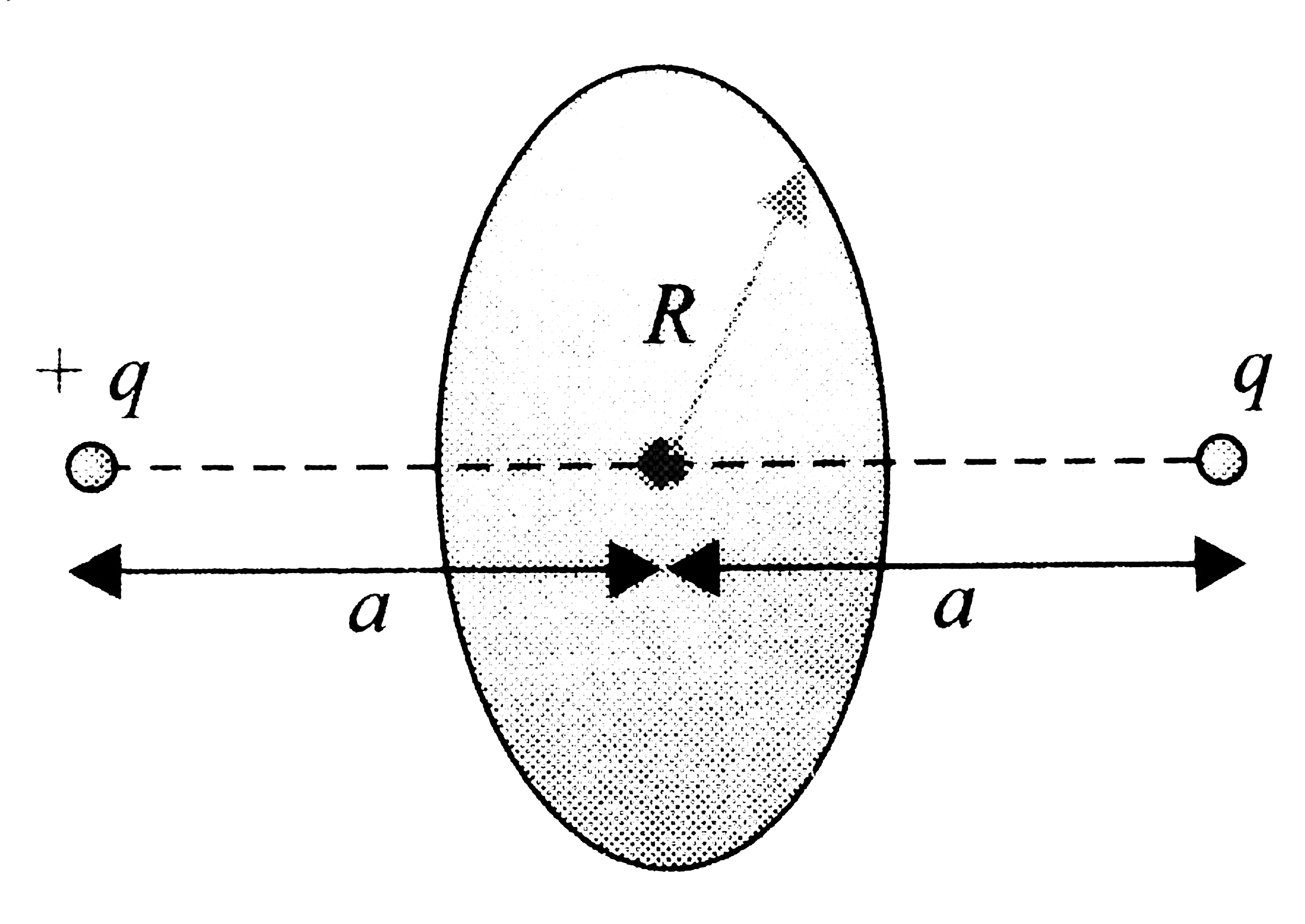Two charges Q1andQ2 are separated by distance r. Under what conditions will the electric field be zero on the line joining them (i) between the charges (ii) outside the charge?
To solve the problem of determining the conditions under which the electric field is zero on the line joining two charges Q1 and Q2, we will analyze two scenarios: (i) when the point is located between the charges and (ii) when the point is located outside the charges.
1. Understanding the Setup:
- We have two charges Q1 and Q2 separated by a distance r.
- We need to find a point P between these two charges where the electric field is zero.
2. Direction of Electric Fields:
- If both charges are of the same sign (both positive or both negative), the electric fields at point P due to both charges will point in the same direction (away from both if positive, towards both if negative).
- Therefore, the electric fields cannot cancel each other out, and the net electric field cannot be zero.
3. Condition for Zero Electric Field:
- For the electric field to be zero at point P between the charges, the charges must be of opposite signs.
- If Q1 is positive and Q2 is negative (or vice versa), the electric fields due to each charge at point P will point in opposite directions.
4. Magnitude Condition:
- The magnitudes of the electric fields due to Q1 and Q2 at point P must be equal for the net electric field to be zero.
- This can be expressed mathematically as:
k|Q1|(r/2)2=k|Q2|(r/2)2
- Simplifying, we find that:
|Q1|=|Q2|
- Thus, the condition is that the charges must be of opposite signs and equal magnitudes.
(ii) Condition for Electric Field to be Zero Outside the Charges
1. Understanding the Setup:
- We now consider a point P located outside the two charges, either to the left of Q1 or to the right of Q2.
2. Direction of Electric Fields:
- If both charges are of the same sign, the electric fields at point P will again point in the same direction (away from both charges), and thus cannot cancel each other out.
3. Condition for Zero Electric Field:
- For the electric field to be zero outside the charges, the charges must be of opposite signs.
- The electric fields due to Q1 and Q2 will point towards each other (if Q1 is positive and Q2 is negative) or away from each other (if Q1 is negative and Q2 is positive).
4. Magnitude Condition:
- The magnitudes of the electric fields at point P must also be equal:
E1=E2
- This leads to the condition:
k|Q1|d21=k|Q2|d22
- Where d1 and d2 are the distances from the point P to Q1 and Q2 respectively.
- For the net electric field to be zero, the charges must be of opposite signs and their magnitudes must be such that their electric fields at point P are equal.
Summary of Conditions
- Between the Charges:
- Charges must be of opposite signs and equal magnitudes.
- Outside the Charges:
- Charges must be of opposite signs and their magnitudes must be such that the electric fields at the point of interest are equal.
- We have two charges Q1 and Q2 separated by a distance r.
- We need to find a point P between these two charges where the electric field is zero.
- If both charges are of the same sign (both positive or both negative), the electric fields at point P due to both charges will point in the same direction (away from both if positive, towards both if negative).
- Therefore, the electric fields cannot cancel each other out, and the net electric field cannot be zero.
- For the electric field to be zero at point P between the charges, the charges must be of opposite signs.
- If Q1 is positive and Q2 is negative (or vice versa), the electric fields due to each charge at point P will point in opposite directions.
- The magnitudes of the electric fields due to Q1 and Q2 at point P must be equal for the net electric field to be zero.
- This can be expressed mathematically as:
k|Q1|(r/2)2=k|Q2|(r/2)2
- Simplifying, we find that:
|Q1|=|Q2|
- Thus, the condition is that the charges must be of opposite signs and equal magnitudes.
- We now consider a point P located outside the two charges, either to the left of Q1 or to the right of Q2.
- If both charges are of the same sign, the electric fields at point P will again point in the same direction (away from both charges), and thus cannot cancel each other out.
- For the electric field to be zero outside the charges, the charges must be of opposite signs.
- The electric fields due to Q1 and Q2 will point towards each other (if Q1 is positive and Q2 is negative) or away from each other (if Q1 is negative and Q2 is positive).
- The magnitudes of the electric fields at point P must also be equal:
E1=E2
- This leads to the condition:
k|Q1|d21=k|Q2|d22
- Where d1 and d2 are the distances from the point P to Q1 and Q2 respectively.
- For the net electric field to be zero, the charges must be of opposite signs and their magnitudes must be such that their electric fields at point P are equal.
- Charges must be of opposite signs and equal magnitudes.
- Outside the Charges:
- Charges must be of opposite signs and their magnitudes must be such that the electric fields at the point of interest are equal.
Topper's Solved these Questions
- BOOK - CBSE COMPLEMENTARY MATERIALCHAPTER - ELECTROSTATICS AND CURRENT ELECTRICITY EXERCISE - SHORT ANSWER QUESTIONS (3 MARKS )23videos
ELECTROSTATICS AND CURRENT ELECTRICITY
- BOOK - CBSE COMPLEMENTARY MATERIALCHAPTER - ELECTROSTATICS AND CURRENT ELECTRICITY EXERCISE - LONG ANSWER QUESTIONS6videos
ELECTROSTATICS AND CURRENT ELECTRICITY
- BOOK - CBSE COMPLEMENTARY MATERIALCHAPTER - ELECTROSTATICS AND CURRENT ELECTRICITY EXERCISE - NUMERICALS49videos
ELECTROSTATICS AND CURRENT ELECTRICITY
- BOOK - CBSE COMPLEMENTARY MATERIALCHAPTER - ELECTRONIC DEVICES EXERCISE - NUMERICALS7videos
ELECTRONIC DEVICES
- BOOK - CBSE COMPLEMENTARY MATERIALCHAPTER - SAMPLE QUESTION PAPER 2019EXERCISE - Section C19videos
SAMPLE QUESTION PAPER 2019
Similar Questions
(a) Two pont charges 9Q and −25Q are fixed at separation d.At what distance from 9Q , electric field is zero on the line joining the charges ?
(b) A circular ring of radius r carries a total charge Q distributed uniformly over it. A small length dl of wire is removed . Find electric field at center due to the remaining ring.View SolutionTwo point charges+ q and-q are placed at distanced apart. What are the points at which the resultant field is parallel to the line joining the two charges ?
View Solution
Knowledge Check
- Question 1 - Select One
Two spheres A and B are charged with the charges of +10 and +20 coulomb respectively and separated by a distance of 80 cm. The electric field at point on the line joining the centres of the two spheres will be zero at a distance from the sphere A :
A20cmB33cmC45cmD60cm - Question 2 - Select One
Two point charges +4q and +q are placed 30cm apart. At what point on the line joining them is the electric field zero
A15 cm from charge qB20 cm from charge 4 qC7.5 cm from charge qD5cm from charge q - Question 3 - Select One
Two charges 4q and q are placed 30 cm. apart. At what point the value of electric field will be zero
A10 cm away from q and between the chargesB20 cm away from q and between the chargesC10 cm away from q and outside the line joining the chargesD10 cm away from 4q and outside the line joining them
Two point charges q and −q are separated by the distance 2l. Find the flux of the electric field strength vector across a circle of radius R.
 View Solution
View SolutionTwo point charges q and -q are separated by a distance 2a. Evaluate the flux of the electric field strength vector across a circle of radius R.
 View Solution
View SolutionTwo point charges 4μCand−2μC are separated by a distance of 1m in air. Calculate at what point on the line joining the two charges is the electric potential zero ?
View SolutionTwo point charges +4μCand−2μC are separated by a distance of 1 m in air. Calculate at what point on the line joining the two charges is the electric potential zero.
View SolutionTwo point charges of 5μC and 20μC are separated by a distance of 2m. Find the point on the line joining them at which electric field intensity is zero.
View Solution

